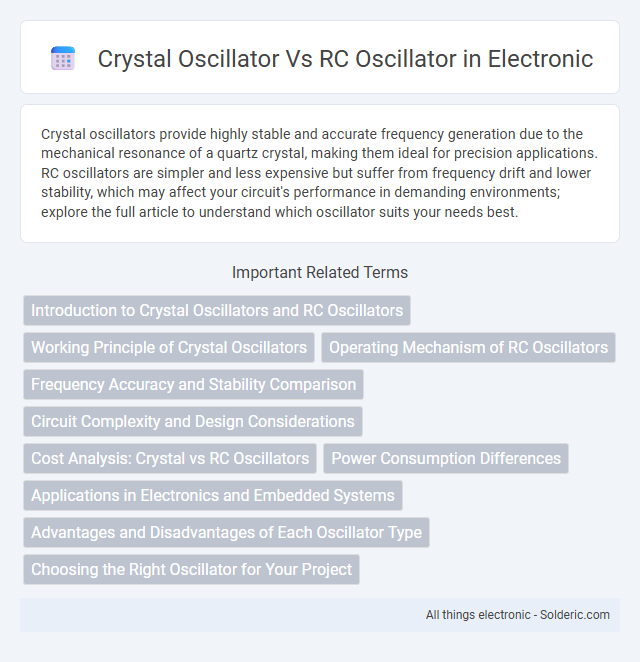Crystal oscillators provide highly stable and accurate frequency generation due to the mechanical resonance of a quartz crystal, making them ideal for precision applications. RC oscillators are simpler and less expensive but suffer from frequency drift and lower stability, which may affect your circuit's performance in demanding environments; explore the full article to understand which oscillator suits your needs best.
Comparison Table
| Feature | Crystal Oscillator | RC Oscillator |
|---|---|---|
| Frequency Stability | High (+-10 ppm or better) | Low (+-1% or worse) |
| Frequency Range | Typically 32 kHz to 100 MHz | Low to mid frequency (up to a few MHz) |
| Accuracy | Very precise | Less precise, depends on temperature and component tolerances |
| Temperature Sensitivity | Low sensitivity | High sensitivity |
| Cost | Moderate to high | Low |
| Size | Compact but larger than RC circuits | Very small and simple |
| Power Consumption | Low to moderate | Low |
| Applications | Microcontrollers, communication, precision clocks | Audio circuits, timers, simple oscillators |
| Startup Time | Longer (milliseconds to seconds) | Shorter (microseconds to milliseconds) |
Introduction to Crystal Oscillators and RC Oscillators
Crystal oscillators leverage the precise mechanical vibrations of quartz crystals to generate highly stable and accurate frequency signals, making them ideal for applications requiring tight frequency control. RC oscillators utilize resistor-capacitor networks to produce oscillations but exhibit less frequency stability and are more susceptible to temperature variations. Understanding the fundamental differences between crystal and RC oscillators helps you select the right oscillator type for your specific timing and signal generation needs.
Working Principle of Crystal Oscillators
Crystal oscillators operate based on the piezoelectric effect, where a quartz crystal resonates at a precise frequency when an electric field is applied. This resonance generates a stable and accurate oscillation frequency used for timing in electronic circuits. Unlike RC oscillators, which rely on resistor-capacitor networks with variable frequency stability, crystal oscillators provide superior frequency precision and low phase noise.
Operating Mechanism of RC Oscillators
RC oscillators generate stable frequency signals using resistors and capacitors to create a phase shift network that provides feedback at the desired oscillation frequency. The phase shift produced by the RC network, typically 180 degrees, combined with the amplifier's 180 degrees, satisfies the Barkhausen criterion for sustained oscillations. Your circuits relying on RC oscillators benefit from their simplicity and ease of tuning, although they generally have lower frequency stability compared to crystal oscillators.
Frequency Accuracy and Stability Comparison
Crystal oscillators exhibit superior frequency accuracy and stability compared to RC oscillators, maintaining precise oscillation frequencies with minimal deviation over time and temperature variations. RC oscillators often experience frequency drift due to resistor and capacitor tolerances and environmental factors, resulting in less reliable and less stable performance. For applications requiring consistent timing and minimal frequency error, your design benefits considerably from the high precision of crystal oscillators.
Circuit Complexity and Design Considerations
Crystal oscillators feature higher circuit complexity due to the inclusion of a quartz crystal, which requires precise load capacitors and stabilization components for accurate frequency control. RC oscillators have simpler circuit designs with resistors and capacitors, making them easier to design but prone to frequency drift caused by temperature and component variances. The design considerations prioritize crystal oscillators for stability and precision in communication and timing applications, while RC oscillators suit cost-sensitive, low-frequency needs.
Cost Analysis: Crystal vs RC Oscillators
Crystal oscillators typically incur higher upfront costs due to their precise quartz crystal components, making them more expensive than RC oscillators. RC oscillators offer a cost-effective solution with simpler circuitry and lower manufacturing expenses, often chosen for budget-sensitive or low-frequency applications. Your decision should weigh the cost against the required frequency stability and accuracy, where crystal oscillators provide superior performance despite the increased investment.
Power Consumption Differences
Crystal oscillators typically exhibit lower power consumption compared to RC oscillators due to their high frequency stability and precise resonant frequency, reducing the need for power-intensive frequency stabilization circuits. RC oscillators consume more power as they rely on continuous charging and discharging of resistors and capacitors, causing higher energy loss in the form of heat. The choice of oscillator impacts the overall energy efficiency in battery-powered or low-power electronic applications significantly.
Applications in Electronics and Embedded Systems
Crystal oscillators are favored in electronics and embedded systems requiring high frequency stability and precision timing, such as microcontrollers, communication devices, and clock generation circuits. RC oscillators, while less accurate, are commonly utilized in applications where cost-efficiency and simplicity matter, including audio frequency generation, clock signals in low-speed microprocessors, and timing circuits in consumer electronics. Your choice between the two influences system reliability, power consumption, and overall performance depending on the application's timing accuracy and environmental conditions.
Advantages and Disadvantages of Each Oscillator Type
Crystal oscillators offer high frequency stability and precision due to their quartz crystal resonators, making them ideal for applications requiring accurate timing such as communication systems and microcontrollers. However, they are typically more expensive, larger in size, and less flexible in frequency adjustment compared to RC oscillators. RC oscillators are cost-effective, compact, and adjustable over a wide frequency range but suffer from poor frequency stability and greater susceptibility to temperature variations and aging effects.
Choosing the Right Oscillator for Your Project
Crystal oscillators provide superior frequency stability and precision, making them ideal for applications requiring accurate timing such as microcontrollers and communication devices. RC oscillators offer flexibility, lower cost, and ease of integration, suitable for applications with less stringent frequency stability requirements like audio or signal processing circuits. Selecting the right oscillator depends on balancing frequency accuracy, power consumption, and cost considerations specific to the project requirements.
crystal oscillator vs RC oscillator Infographic

 solderic.com
solderic.com